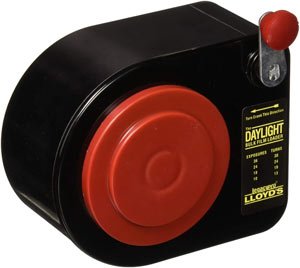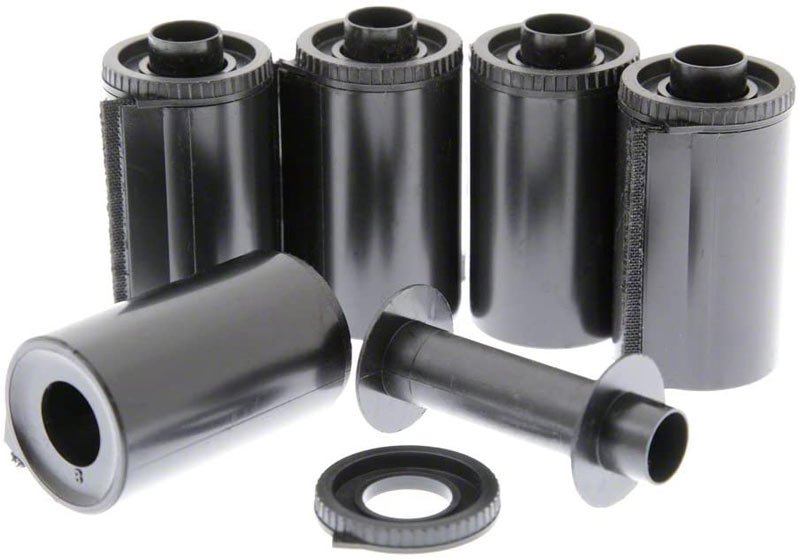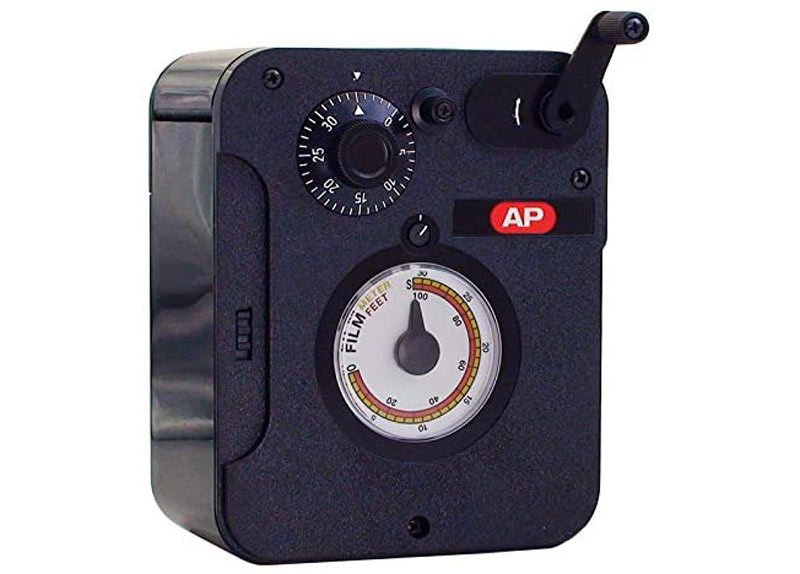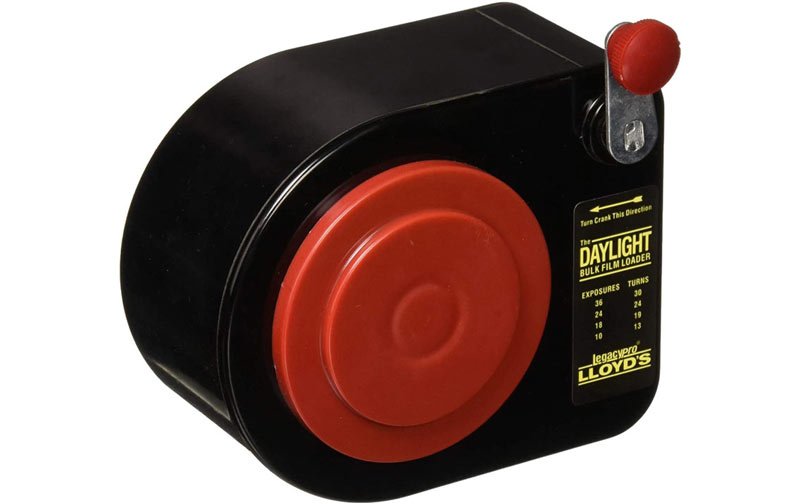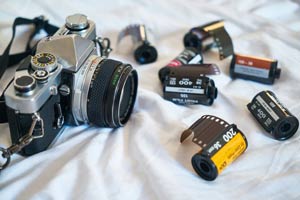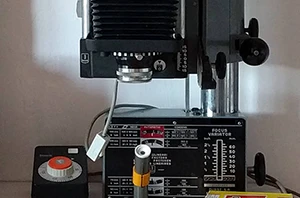What is a bulk film loader?
A bulk film loader, also known as film winder, is a device that fascilitates the winding of 35mm film from a bulk roll into a camera cartridge. While this can be done manually in a darkroom, a bulk film loader greatly simplifies the process. Buying film in bulk rolls offers significant savings over pre-rolled films while providing increased control over your workflow.
As opposed to manual film spooling, using a bulk film loader all but eliminates time spent in the darkroom (or changing bag). The only task that needs to happen in the dark is the initial loading of the film winder with the bulk 35mm roll. All subsequent steps to get a film cartridge spooled can happen in broad daylight.
How do you use a bulk film loader?
Bulk film loaders come in many different shapes and designs, but they all operate on pretty much the same principle. You hit the darkroom (or film changing bag/tent) and stick a 100′ (30.5m) bulk roll of 35mm film stock in the loader. Before you get going, do consult the manual of your particular model for any specifics or quirks it may have.
Pretty much all film manufacturers offer standard 100′ bulk loader compatible rolls. You can also use motion picture film short ends or re-cans in a bulk loader, although you might have to do some respooling in the darkroom to get the roll to the appropriate size. Do not forget to label you bulk loader with the film stock you’ve got inside, especially if you have several loaders. If you switch between films often, it’s easy to forget what’s inside. If you do, the only way to find out would be to do a clip test.
Once your bulk loader is prepped with fresh film stock inside, you can come out of the dark and start loading up your film cartridges. Basically, you attach the end of the bulk roll sticking from the loader to the casette core, then place the casette inside the loader, close it and crank. Many bulk loaders have a guide printed on the device itself to tell you how many turns you need to crank the mechanism to get different shot counts on the casette.
For example, on the LegacyPro model pictured above 30 turns of the crank gets you a standard 36 exposure roll. Other models like the AP Film Winder have automatic counters on which you can preset the required roll length. The third approach is used in the Alden bulk loaders among others. They make an audible click for each frame you spool on the casette, making loading odd numbers of shots quick and easy.
Once you’ve spooled enough film you can open the bulk loader cut the film and remove the casette. As with the loader itself, label the casette as soon as you have it out. It’s even easier to mix up a bunch of mislabeled 35mm casettes.
Cassettes
Dedicated bulk roll reloadable casettes
You can get brand new, empty reloadable 35mm film cassetes and even equip them with canisters for a professional finish. To attach the leader to the core, you need to disasemble the casette. These casettes usually have a knurled cap on one side that twists or pops off. Remove the cap, pull out the core and thread the end of the new film throug. You might have to shape the end with scissors to get it in.
Make sure you get a positive engagement to avoid the film pulling out when you start cranking the loader or rewinding it after shooting. Once you’re done, carefully slide the film in the light trap and reasemble the casette. Pay attention to the light trap, making sure it’s nice and straight, with no kinks, fraying, dirt or grime to mess up the sensitive emulsion.
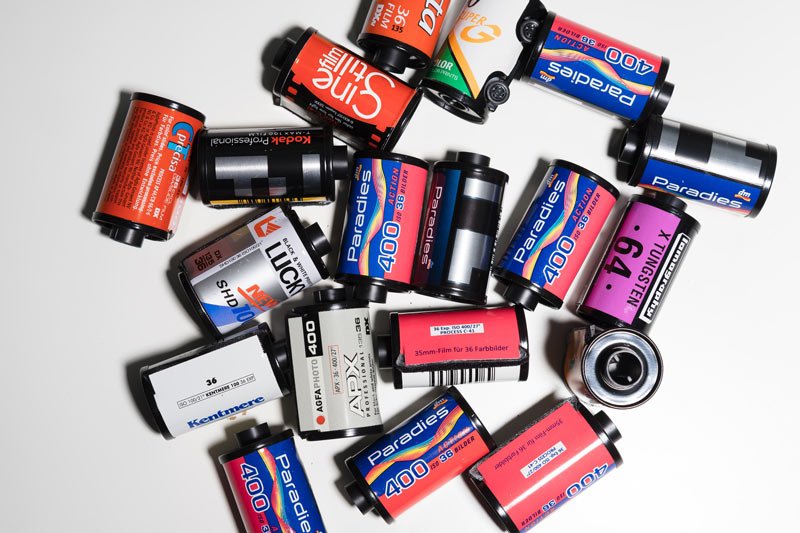
Reusing old casettes
Alternatively, you can also reuse regular metal 35mm cassetes. There are a couple of way to do this. The first method only works if you do not open your casettes with an opener, but use a film leader retriever or simply do not rewind your film all the way in. When you remove the exposed film for development, cut it by leaving a couple of centimeters attached to the roll in the casette. To reload the casette, simply tape the new film’s end to this leader and then proceed as normal. This is the least invasive method, the integrity of the casette is preserved, and the chances of a light leak minimal.
If you have no leftover film tail sticking out of the casette or it has been opened with an opener, you can still try and reuse it. First inspect the casette carefully to see if the process of opening it has damaged it. Metal casettes are not designed to be reusable, and the caps are pressed on. Depending on the opener, the cap removal may cause quite a bit of damage on the casette. Look for big dings, bends in the body or damage to the light seal. If you see any of this, do not reuse the cartridge.
Loading such a casette is very similar to using a plastic reloadable casette. The only difference is the way you close it after threading the film leader through the core. You need to press the cap firmly onto the casette until you’ve got a secure fit. Some casettes close easier than others, and some simply cannot be put back together.
DX Coding
A little detail you need to consider when bulk loading 35mm film is DX coding. The DX code is the barcode-like series of sliver and black patches found on pretty much all 35mm film casettes today. Many cameras rely on the DX codes to automatically set the ISO speed for internal metereing.
Some models would allow you to manually select ISO if no DX code is detected, but a number of point and shoot compacts do not have manual override. When they find no DX coding, these cameras would usually default to a preset EI, you can usually find this in the camera’s manual. For these models, the DX coding is the only way to set the proper exposure index.
If you use a camera that relies on DX coding, you need to be aware of the technollogy and how you can use it to your advantage. One approach is to reuse standard 35mm casettes from the same speed film that you plan to bulk load in them. For example, if you have a roll of Ilford HP5+ 400 ISO film in your bulk loader, you can reuse any 400 ISO casette you can find, as long as it has a DX code. You don’t need to use a casette by the same manufacturer, as DX codes are universal across the industry.
If you are using plastic reloadable casettes or if you only have spare casettes with a wrong DX index, you have a couple of options. The easiest one is to buy self-adhesive DX code stickers sold by some photographic supplies companies. They may be hard to find, but if you do find them, the job is as easy as getting the correct ISO sticker and applying it to your casettes. Your second option is to get creative, creating your own DX label using one of the many guides available online.
Do you need a bulk film loader?
A bulk film loader is a useful device if you find yourself going through large quantities of 35mm film. The device can help you save money over pre-rolled film while giving you the flexibility of only spooling on as much film as you need. For example, you get a new film type and want to try several frames? Instead of shooting a whole 36 exposure roll, you can spool just 10 shots into a casette and get going.
Some specialist film emulsions only come in bulk packaging. Technical film or motion picture emulsions are only supplied in large canisters. Granted, there are companies like CineStill that offer respooled casettes of such emulsions, but if you want to do it yourself and save money, a bulk film loader would be a useful addition to your kit. It will also be a godsend if your friendly local clapper-loader pushes a couple of short ends your way.
If you have no access to a darkroom but still want to try bulk emulsions, a bulk film loader would save you a lot of fumbling with the changing bag. Granted, you’ll still need one to load the bulk roll into the loader, but once this is done all the subsequent steps can be done out in the light.
What is the best bulk film loader?
A popular accessory in the recent past, bulk film loaders are not as poplar today. Few manufacturers have kept their production, and no new makers have entered the market recently. If you are on the market for a new bulk film loader, you have just a couple of options.
The AP 35mm Film Winder is one of the most popular and reliable models available new today. It can also be found under the Kaiser brand name. It comes with a counter that lets you set your desired roll length and an indicator needle to show how much of the bulk roll is left. A clever design feature prevents the casette door from opening whenever the removable winding handle is in it’s slot. This prevents accidental opening of the door and fogging the film mid-rolling.
LegacyPro Lloyd’s Daylight Bulk Film Loader is a slightly cheaper but equally competent device. Simpler in it’s construction, it does not have the advanced counter features of the AP. You have to keep count on your cranks and number of rolls as the device will not do it for you.
What are bulk film loader alternatives?
What a bulk loader does is to streamline the process of getting 35mm film off a bulk roll and into a canister. However, everything that the bulk loader does can be done done manually in a darkroom. If you have the space, time and patience there’s nothing stoping you from going all hands on.

